T-34 against "Panther" (14 photos)
 Bashny.Net
Bashny.Net
In response to the growth of Soviet tanks, the Germans have committed themselves to the creation of many complex, but the limited-edition models of armored vehicles
A number of publications have challenged one of the most enduring judgments of national historiography - "T-34 - the best tank of the Second World War." However, I would like to warn against the passions of the "re-discovered the truth." We subconsciously seek to extremely simple explanations of complex phenomena of history, taking over the function of the simplicity of truth. As a result, to replace the simple scheme: "Soviet - means better, and therefore won" comes another, no less simple: "Soviet - the worst, but more numerous, won number».
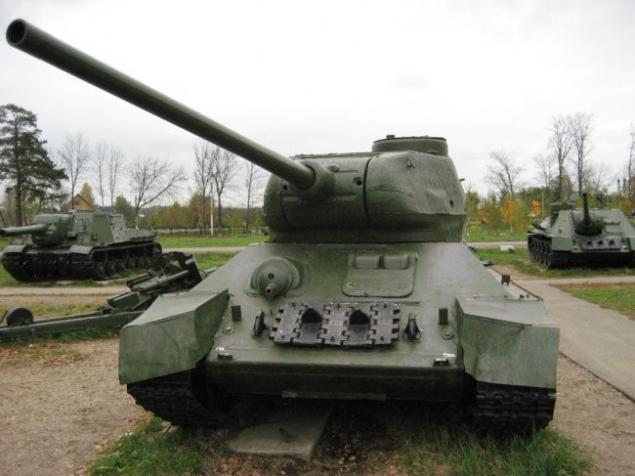
In this connection I would like to add one important aspect that allows you to look at the picture of the Soviet-German technical confrontation with some unexpected side and realize that the true content of the process immeasurably harder charming simplicity of our schemes. This aspect of mental warfare in World War II.
Mental attitude
The tank, as well as any technical object, the idea has materialized, reflect the views of the authors of the functions of the object. Because of this, the mental aspect of a technical object is represented as a set of hierarchically built its essential characteristics. And any technical object is the result of a compromise between mutually exclusive requirements. This means the designer (customer) initially appears in a situation of choice when determining what to sacrifice and what to give preference: protection or mobility or firepower ...
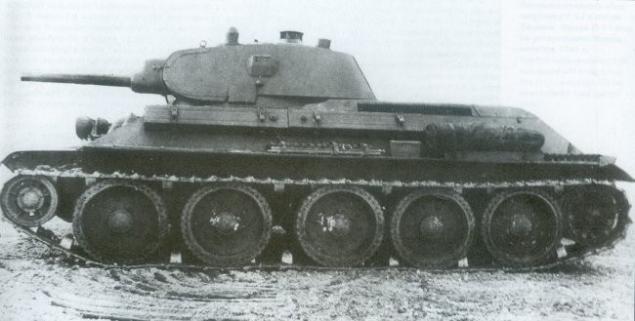
It was at the moment of choice and triggered "mental attitude" as a constructor (the customer) is guided in this by some fundamental values - literally, what is good and what is bad, what is important, and that - no, what is permissible and what - is not possible. And, as history shows, these trade-offs in the interpretation of different national schools strikingly different design, which was a direct result of differences in national mental plants, defining core values.
Overwhelming, but to no avail EXCELLENCE
By 1941, the T-34 is the most advanced medium tank, embodied all the achievements of Soviet design ideas and industry, his antagonist in the same "weight class" was the German medium tank Pz-IV. If you compare their characteristics, taking figures Pz-IV for 100% by the beginning of the war Soviet tank had absolute superiority over the Pz-IV in the protection - factor 219, 3, a significant advantage in mobility - the coefficient 136, 1, a significant firepower - 121, 4, and completely inferior to the comfort of the crew and operation - factor of 48, 3.

If these data are supplemented by benchmarking layout scheme of T-34 and Pz-IV, it will become clear how the Soviet designers managed to achieve such a significant advantage over the enemy, and what was the price of this superiority.
The main advantage of the T-34 - in defense - has been achieved through the increased use of (so-called rational) angles armor - up to 60 degrees in the front and 45 degrees to the side view. But because of the declination sheets of armor fell into the reserved volume hull and turret. As a result, the 26-ton tank (issue 1940, 1941 weight by up to 28 m) is closely even for four crew members and the crew of the German 20-ton Pz-IVD included five people!
Closely Thirty tower housed only two - load a gun and the commander, Acting gunner. In real combat conditions it distracted the commander of the main responsibilities of execution - their own tank and control of subordinate units - platoon, company, battalion. Installation on the T-34 a powerful 76-mm cannon F-34 and the marker of the diesel engine is also absorbed an additional amount of the crew compartment.
The advantage to protect the T-34 was provided and a small number of operational and working hatches - 5 to 12, at Pz-IVD. Each member of the crew of a German tank had its own hatch, while the Soviet tank was only two hatches for four. Needless to say, what it meant in terms of combat.
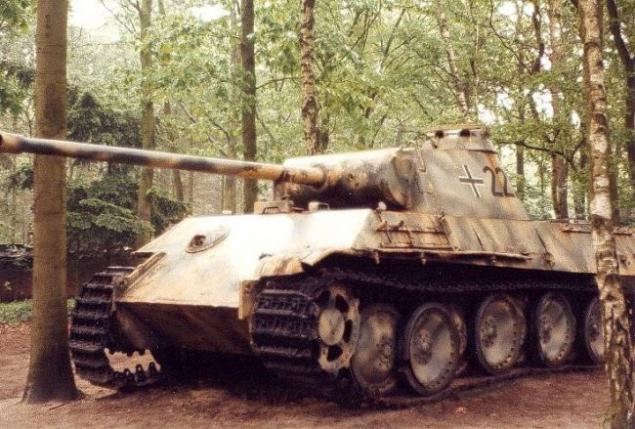
These shortcomings were compounded by the poor quality and design flaws observation instruments, stood at the beginning of the 1930s. All of this T-34 tanks inherited from the previous series BT-5 and BT-7. This little-known fact is contrary to a common view in the literature, according to which the T-34 tank was conceived as a new generation. In fact, the T-34 emerged as a result of consistent and deep modernization of the BT-7.
As a result, the benefits of the T-34 protection and firepower were "bought" at the cost of colossal gap in performance, especially in the comfort of the crew. Choosing between protection, firepower and convenience, Soviet designers unlike their opponents prefer to sacrifice the convenience.
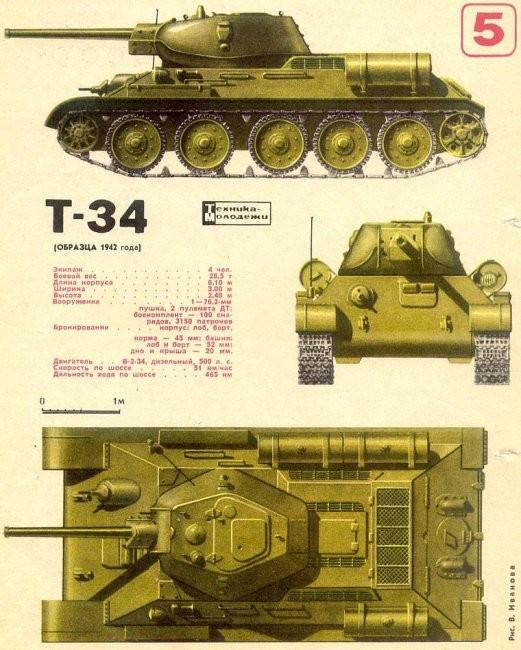
"Thirty" was a kind of "people tank" concept reflected in her mental attitudes not only engineers, but also tankers. Monitoring devices, communications, working conditions of the crew of any tank crews or designers are not considered as comparable in importance with the firepower, protection and mobility.
Another inherent in T-34, a combination of pros and cons - the priority of simplicity and low cost structure to the detriment of qualitative characteristics of the structure as a whole. A characteristic feature of the layout of the T-34, also inherited from the BT series, was the location of the engine and transmission setup in the rear of the machine. Germans in all their tanks use separate scheme - the engine in the stern, mission ahead. Driving the T-34 had its advantages. The main thing - ease of installation and maintenance. The downside was the drive system control, going through the tank from the place of the driver to the transmission, which greatly increases the force on the control lever and makes it difficult to switch gears.
Similarly, Soviet tank applied to an individual spring suspension system with large-diameter rollers being in comparison with the suspension Pz-IV is very simple and cheap to manufacture, was placed in overall and hard to move. Suspension System T-34 tanks, also inherited from the BT series. Simple and adaptability to manufacture, it is because of the large size of the rollers, and hence the small number of control points on tracks (five instead of eight at the Pz-IV), and spring amortization led to a strong rocking motion of the machine, making it completely impossible to fire go. In addition, in comparison with the torsion bar suspension, she held a 20% larger volume.

In assessing the overall mental component design T-34, it can be said that his superior protection, mobility and firepower was achieved at the expense of convenience and efficiency. A direct consequence of this was the beginning of the war a paradoxical situation when the T-34 because of the pressure of the commander and the bad observation instruments, shortcomings transmission could not exercise their absolute superiority over the enemy tanks. The conclusion that the overwhelming superiority of the T-34 was made by German generals only four months after the war, although in June-July 1941, numerous examples of new Soviet tanks were sent to Germany to study. Apparently, in the summer of 1941, German experts were unable to appreciate the T-34 because of the low level of technical perfection.
GERMAN ANSWER
The immediate response to the "challenge to the T-34" was the modernization of the German tanks. And that answer is very clearly manifested mental peculiarities to solve the problem of increase of efficiency of the tank as an object of national technical culture.
In the spring of 1942, the Wehrmacht appear Pz-IV modifications «F» and «G», in which the experiences of armed clashes with Soviet tanks. German designers dramatically increase the firepower by installing a new gun - KwK40 with a barrel length of 48 calibers (instead of the previous KwK37 cannon with a barrel 24 gauge), which increased armor penetration to 1, 6 times. Significantly enhanced booking - 66% forehead hull and turret, and 50% - the side hull and turret. This was achieved by increasing the weight of Pz-IV 3, 5 m and a decrease in mobility. But the main thing was still preserve the former conditions of the crew. In other words, for the sake of German designers gain firepower and protection prefer to donate only mobility, but not convenience.
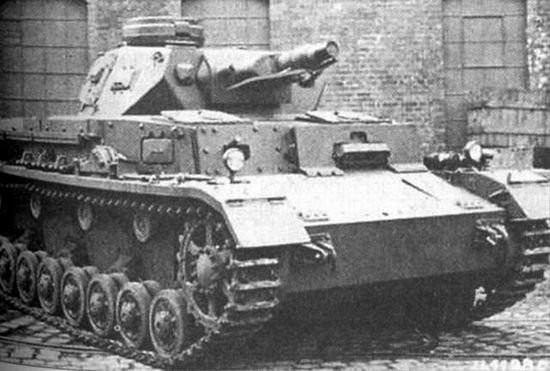
During the first year of the war the T-34 has also undergone modernization. Designers have tried to remove the most glaring defects of the machine. Was improved transmission, air cleaners, increased ammunition, etc. The most notable change in the structure "Thirty" was the development of a new tower. However, the reason for this was not the desire to improve the working conditions of the crew, and finally make a triple tower, and technology requirements. The new tower was more easy to produce - Now it can be molding machine manufacturing, stamped with a powerful press and use automatic welding during assembly. In other words, changes in the T-34 were motivated by other than that of Pz-IV, a priority - a simplification and reduction in the cost of production. The task of increasing, or at least save the fire superiority over the modernized German tanks was not even raised.
Comparison of the T-34 with upgraded Pz-IVG shows that Soviet tank still maintains its advantage in defense, but the superiority factor was reduced from 219 to 3 179, 6. The relative mobility of the Soviet tank even increased - from 130 to 4 137, 9, but the ratio has changed dramatically firepower - to 121, 4 it has dropped to 93, 2. Improved Pz-IV caught up with the T-34 in the effective distance of fire fighting and at a distance of 900-1000 m of their shells punched frontal armor hull and turret Soviet tank. To maintain its advantage in the convenience of the crew, especially in observation devices and fire control, upgraded Pz-IV has received a clear advantage over the fire T-34 long-range combat.
As a result, in the spring of 1942, German engineers, limiting modest changes in the design of Pz-IV, decided to "the problem of the T-34." Modernized German tanks very successfully fought the Soviet Thirty.
In pursuit of absolute supremacy
It would seem that the German High Command had every reason to direct their further efforts to expand production of upgraded tanks, securing thus achieve excellence. However, the summer of 1942 it was decided to start building new tanks Pz-V «Panther" and Pz-VI «Tiger". The reasons for this were not operational-strategic or military-technical nature, because in this period the German troops have made very impressive progress.
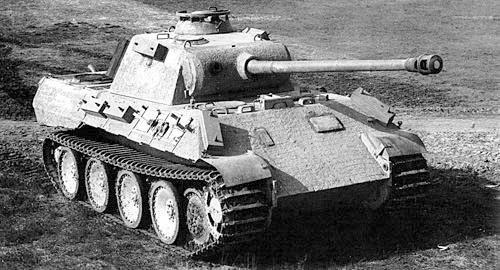
The emergence of "Tigers" and "Panthers" explained solely by the desire of the German leadership to restore shattered the technical superiority of German arms. In autumn 1941, this superiority was challenged by successful actions of the Soviet "tridtsatchetverok" and then was tasked with "back to achieve technical superiority over the Russian." The superiority of the T-34 was taken by the Germans very painful, as a sort of challenge, as something that is contrary to notions of features inherent in the German nation, its culture, including technical. In other words, the superiority of the T-34 was seen as a mental challenge it.
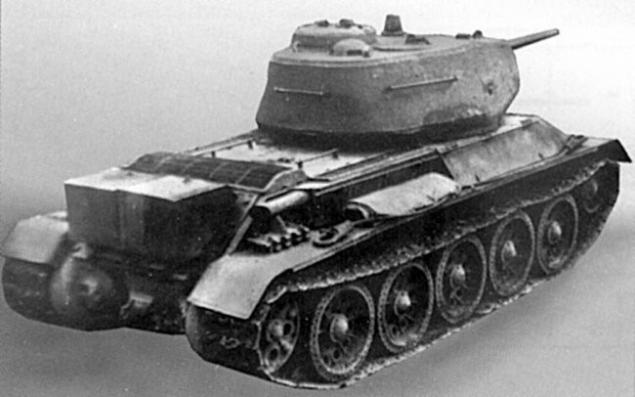
A comparison of the characteristics of the T-34 and the "Panther" shows that with the advent of the new German tank almost all the relative indicators Thirty plummeted. So, firepower has decreased from 93, 2 (with respect to Pz-IVG) 70, 3, the usability of the Soviet crew to 52, 7 to 39, 4. Despite the fact that the "Panther" was very heavy and large (the figures for T-34 - 20% less), the German designers managed to almost catch up with the "Thirty" in mobility. In this hard to believe, but almost 45-ton Pz-V only 6% inferior to the mobility of the 28-ton T-34. (Pz-IV conceded "Thirty" nearly 38%). Even former advantage of T-34 Protection has been reduced to a minimum - to 111, 4. T-34 kept the advantage in booking before the "Panther" only due to the greater thickness of armor in the secondary sections - roof, side and stern of the tower, the side and bottom of the hull. At the same time, "Panther" had a double advantage in booking the most dangerous areas - forehead hull and turret.
As a modernized Pz-IV, «Panther" differed sharply increased firepower. But, like the Pz-IV, it was achieved while maintaining the same caliber by increasing the length of the barrel 70 gauge, resulting in improved armor penetration of the new instruments in 1, 6 times.
The frontal "Panther" 80 mm was angled 55 degrees, which increases its armor protection twice. In a similar situation with the T-34, this has led to a significant reduction in the internal volume of the tank hatch and forced placement of the driver in the frontal. However, in the case of the Pz-V, we have just the opposite result - the largest internal volume booked it surpasses all Soviet and most German tanks.
The secret is simple. German designers were not tilted armor plates inside, thereby reducing the amount booked and pushed them to the outside (!), Increasing the amount. The main disadvantage - a substantial increase in the size and weight of the tank. By weight - 45 tons Pz-V far surpassed the T-34 (28, 5 m) and almost on par with the Soviet "heavyweights" - HF (47, 5 m) and IP (46 m).
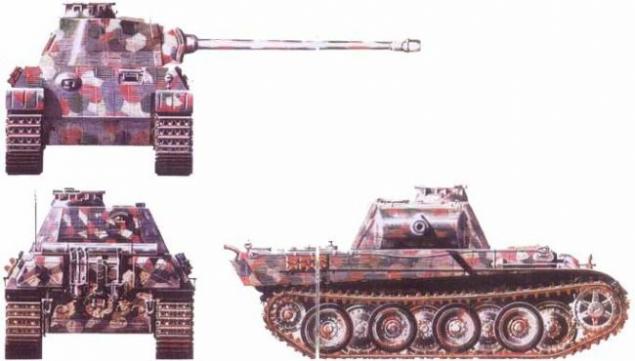
As a result, the authors of the "Panther" was able to dramatically increase the protection, firepower, mobility, thus improving the working conditions of the crew, sacrificing only an increase in size and weight. The emergence of Pz-V «Panther" on the battlefield dramatically changed the balance of forces. The new German tanks could hit the frontal armor of the T-34 at a distance of 1500 meters, while the "Thirty" was necessary for this approach to a distance less than 100 m.
The Soviet counter-arguments
The true quality of the new German tanks appeared in dramatic fashion in the summer of 1943 during the Battle of Kursk. Now the "Panther" and "Tiger" with impunity shot T-34 and KV with unimaginable for us distances of 1, 5-2 km, while remaining invulnerable themselves. Our avowed victory at Kursk turned to the Soviet armored forces heavy losses. According to official data, in the Kursk defensive operation was lost 1614 tanks and self-propelled guns from 5130 to the beginning of the available. Daily losses are accounted for 85 machines. Value of losses on the battlefield was 1: 3 in favor of the enemy.
And our response to this challenge is also clearly shown its mental component. The response to the emergence of "Panther" was the T-34-85. New "Thirty" managed to catch up with the "Panther" firepower - the coefficient 102, 7; some measure of protection to improve - to 118, 3; dramatically improved the working conditions were crew T-34-85 - 83, 7 And all this - with a slight decrease in mobility - up to 103, 5. Due to what has been achieved such impressive results?
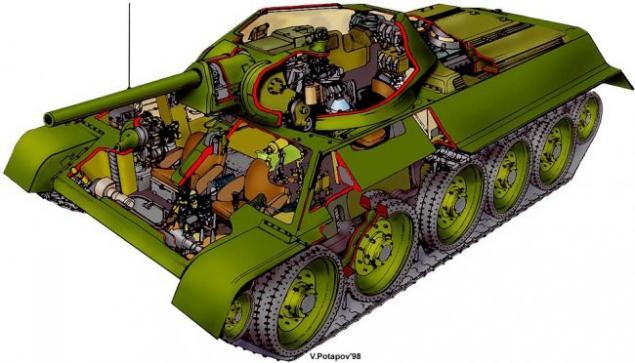
Recall that the Germans, trying to dramatically increase the firepower of the "Panther", armed it with a new, specially designed gun Kwk42, with the same caliber of 75 mm, and Pz-IV. Conservation of previous caliber had a number of advantages - managed to avoid significant increase in weight and size, keep the size of ammunition and rate of fire. The downsides to this option were limited maneuver fire because of the large - about 5 meters - the length of the barrel and increased ease of manufacture. But the main thing - the Germans were forced by the war to go on all the costs of creating and running a series of completely new tools.
Soviet designers chose a different path. Firepower new "Thirty" was provided by increasing the caliber guns - from 76 to 85 mm. At the same time, we will certainly lose all the advantages that gave the preservation of the former caliber, but won in the increase in armor penetration 1, 7 times as compared to the T-34. Now weapon "Thirty" punched frontal armor tower Pz-V from a distance of 1000 m, and side armor hull and turret from a distance up to 2000 m.
But the main thing else - the basis for a new tank gun S-53 was taken 85 mm anti-aircraft gun, model 1939, which significantly reduced the cost and accelerate the production of tank shells. In other words, Soviet designers did not "philosophize slyly," and take what suits the characteristics. Again, the main priority was the simplicity and hence low cost of construction. As a result of minimal changes in the design of the T-34 (enlarged tower with a new instrument), Soviet designers have managed to minimize the advantages of the new German tanks, finding thus, it is an adequate response to the "challenge" Panthers ».
PRICE technical excellence
Why is that?
A number of publications have challenged one of the most enduring judgments of national historiography - "T-34 - the best tank of the Second World War." However, I would like to warn against the passions of the "re-discovered the truth." We subconsciously seek to extremely simple explanations of complex phenomena of history, taking over the function of the simplicity of truth. As a result, to replace the simple scheme: "Soviet - means better, and therefore won" comes another, no less simple: "Soviet - the worst, but more numerous, won number».

In this connection I would like to add one important aspect that allows you to look at the picture of the Soviet-German technical confrontation with some unexpected side and realize that the true content of the process immeasurably harder charming simplicity of our schemes. This aspect of mental warfare in World War II.
Mental attitude
The tank, as well as any technical object, the idea has materialized, reflect the views of the authors of the functions of the object. Because of this, the mental aspect of a technical object is represented as a set of hierarchically built its essential characteristics. And any technical object is the result of a compromise between mutually exclusive requirements. This means the designer (customer) initially appears in a situation of choice when determining what to sacrifice and what to give preference: protection or mobility or firepower ...

It was at the moment of choice and triggered "mental attitude" as a constructor (the customer) is guided in this by some fundamental values - literally, what is good and what is bad, what is important, and that - no, what is permissible and what - is not possible. And, as history shows, these trade-offs in the interpretation of different national schools strikingly different design, which was a direct result of differences in national mental plants, defining core values.
Overwhelming, but to no avail EXCELLENCE
By 1941, the T-34 is the most advanced medium tank, embodied all the achievements of Soviet design ideas and industry, his antagonist in the same "weight class" was the German medium tank Pz-IV. If you compare their characteristics, taking figures Pz-IV for 100% by the beginning of the war Soviet tank had absolute superiority over the Pz-IV in the protection - factor 219, 3, a significant advantage in mobility - the coefficient 136, 1, a significant firepower - 121, 4, and completely inferior to the comfort of the crew and operation - factor of 48, 3.

If these data are supplemented by benchmarking layout scheme of T-34 and Pz-IV, it will become clear how the Soviet designers managed to achieve such a significant advantage over the enemy, and what was the price of this superiority.
The main advantage of the T-34 - in defense - has been achieved through the increased use of (so-called rational) angles armor - up to 60 degrees in the front and 45 degrees to the side view. But because of the declination sheets of armor fell into the reserved volume hull and turret. As a result, the 26-ton tank (issue 1940, 1941 weight by up to 28 m) is closely even for four crew members and the crew of the German 20-ton Pz-IVD included five people!
Closely Thirty tower housed only two - load a gun and the commander, Acting gunner. In real combat conditions it distracted the commander of the main responsibilities of execution - their own tank and control of subordinate units - platoon, company, battalion. Installation on the T-34 a powerful 76-mm cannon F-34 and the marker of the diesel engine is also absorbed an additional amount of the crew compartment.
The advantage to protect the T-34 was provided and a small number of operational and working hatches - 5 to 12, at Pz-IVD. Each member of the crew of a German tank had its own hatch, while the Soviet tank was only two hatches for four. Needless to say, what it meant in terms of combat.

These shortcomings were compounded by the poor quality and design flaws observation instruments, stood at the beginning of the 1930s. All of this T-34 tanks inherited from the previous series BT-5 and BT-7. This little-known fact is contrary to a common view in the literature, according to which the T-34 tank was conceived as a new generation. In fact, the T-34 emerged as a result of consistent and deep modernization of the BT-7.
As a result, the benefits of the T-34 protection and firepower were "bought" at the cost of colossal gap in performance, especially in the comfort of the crew. Choosing between protection, firepower and convenience, Soviet designers unlike their opponents prefer to sacrifice the convenience.

"Thirty" was a kind of "people tank" concept reflected in her mental attitudes not only engineers, but also tankers. Monitoring devices, communications, working conditions of the crew of any tank crews or designers are not considered as comparable in importance with the firepower, protection and mobility.
Another inherent in T-34, a combination of pros and cons - the priority of simplicity and low cost structure to the detriment of qualitative characteristics of the structure as a whole. A characteristic feature of the layout of the T-34, also inherited from the BT series, was the location of the engine and transmission setup in the rear of the machine. Germans in all their tanks use separate scheme - the engine in the stern, mission ahead. Driving the T-34 had its advantages. The main thing - ease of installation and maintenance. The downside was the drive system control, going through the tank from the place of the driver to the transmission, which greatly increases the force on the control lever and makes it difficult to switch gears.
Similarly, Soviet tank applied to an individual spring suspension system with large-diameter rollers being in comparison with the suspension Pz-IV is very simple and cheap to manufacture, was placed in overall and hard to move. Suspension System T-34 tanks, also inherited from the BT series. Simple and adaptability to manufacture, it is because of the large size of the rollers, and hence the small number of control points on tracks (five instead of eight at the Pz-IV), and spring amortization led to a strong rocking motion of the machine, making it completely impossible to fire go. In addition, in comparison with the torsion bar suspension, she held a 20% larger volume.

In assessing the overall mental component design T-34, it can be said that his superior protection, mobility and firepower was achieved at the expense of convenience and efficiency. A direct consequence of this was the beginning of the war a paradoxical situation when the T-34 because of the pressure of the commander and the bad observation instruments, shortcomings transmission could not exercise their absolute superiority over the enemy tanks. The conclusion that the overwhelming superiority of the T-34 was made by German generals only four months after the war, although in June-July 1941, numerous examples of new Soviet tanks were sent to Germany to study. Apparently, in the summer of 1941, German experts were unable to appreciate the T-34 because of the low level of technical perfection.
GERMAN ANSWER
The immediate response to the "challenge to the T-34" was the modernization of the German tanks. And that answer is very clearly manifested mental peculiarities to solve the problem of increase of efficiency of the tank as an object of national technical culture.
In the spring of 1942, the Wehrmacht appear Pz-IV modifications «F» and «G», in which the experiences of armed clashes with Soviet tanks. German designers dramatically increase the firepower by installing a new gun - KwK40 with a barrel length of 48 calibers (instead of the previous KwK37 cannon with a barrel 24 gauge), which increased armor penetration to 1, 6 times. Significantly enhanced booking - 66% forehead hull and turret, and 50% - the side hull and turret. This was achieved by increasing the weight of Pz-IV 3, 5 m and a decrease in mobility. But the main thing was still preserve the former conditions of the crew. In other words, for the sake of German designers gain firepower and protection prefer to donate only mobility, but not convenience.

During the first year of the war the T-34 has also undergone modernization. Designers have tried to remove the most glaring defects of the machine. Was improved transmission, air cleaners, increased ammunition, etc. The most notable change in the structure "Thirty" was the development of a new tower. However, the reason for this was not the desire to improve the working conditions of the crew, and finally make a triple tower, and technology requirements. The new tower was more easy to produce - Now it can be molding machine manufacturing, stamped with a powerful press and use automatic welding during assembly. In other words, changes in the T-34 were motivated by other than that of Pz-IV, a priority - a simplification and reduction in the cost of production. The task of increasing, or at least save the fire superiority over the modernized German tanks was not even raised.
Comparison of the T-34 with upgraded Pz-IVG shows that Soviet tank still maintains its advantage in defense, but the superiority factor was reduced from 219 to 3 179, 6. The relative mobility of the Soviet tank even increased - from 130 to 4 137, 9, but the ratio has changed dramatically firepower - to 121, 4 it has dropped to 93, 2. Improved Pz-IV caught up with the T-34 in the effective distance of fire fighting and at a distance of 900-1000 m of their shells punched frontal armor hull and turret Soviet tank. To maintain its advantage in the convenience of the crew, especially in observation devices and fire control, upgraded Pz-IV has received a clear advantage over the fire T-34 long-range combat.
As a result, in the spring of 1942, German engineers, limiting modest changes in the design of Pz-IV, decided to "the problem of the T-34." Modernized German tanks very successfully fought the Soviet Thirty.
In pursuit of absolute supremacy
It would seem that the German High Command had every reason to direct their further efforts to expand production of upgraded tanks, securing thus achieve excellence. However, the summer of 1942 it was decided to start building new tanks Pz-V «Panther" and Pz-VI «Tiger". The reasons for this were not operational-strategic or military-technical nature, because in this period the German troops have made very impressive progress.

The emergence of "Tigers" and "Panthers" explained solely by the desire of the German leadership to restore shattered the technical superiority of German arms. In autumn 1941, this superiority was challenged by successful actions of the Soviet "tridtsatchetverok" and then was tasked with "back to achieve technical superiority over the Russian." The superiority of the T-34 was taken by the Germans very painful, as a sort of challenge, as something that is contrary to notions of features inherent in the German nation, its culture, including technical. In other words, the superiority of the T-34 was seen as a mental challenge it.

A comparison of the characteristics of the T-34 and the "Panther" shows that with the advent of the new German tank almost all the relative indicators Thirty plummeted. So, firepower has decreased from 93, 2 (with respect to Pz-IVG) 70, 3, the usability of the Soviet crew to 52, 7 to 39, 4. Despite the fact that the "Panther" was very heavy and large (the figures for T-34 - 20% less), the German designers managed to almost catch up with the "Thirty" in mobility. In this hard to believe, but almost 45-ton Pz-V only 6% inferior to the mobility of the 28-ton T-34. (Pz-IV conceded "Thirty" nearly 38%). Even former advantage of T-34 Protection has been reduced to a minimum - to 111, 4. T-34 kept the advantage in booking before the "Panther" only due to the greater thickness of armor in the secondary sections - roof, side and stern of the tower, the side and bottom of the hull. At the same time, "Panther" had a double advantage in booking the most dangerous areas - forehead hull and turret.
As a modernized Pz-IV, «Panther" differed sharply increased firepower. But, like the Pz-IV, it was achieved while maintaining the same caliber by increasing the length of the barrel 70 gauge, resulting in improved armor penetration of the new instruments in 1, 6 times.
The frontal "Panther" 80 mm was angled 55 degrees, which increases its armor protection twice. In a similar situation with the T-34, this has led to a significant reduction in the internal volume of the tank hatch and forced placement of the driver in the frontal. However, in the case of the Pz-V, we have just the opposite result - the largest internal volume booked it surpasses all Soviet and most German tanks.
The secret is simple. German designers were not tilted armor plates inside, thereby reducing the amount booked and pushed them to the outside (!), Increasing the amount. The main disadvantage - a substantial increase in the size and weight of the tank. By weight - 45 tons Pz-V far surpassed the T-34 (28, 5 m) and almost on par with the Soviet "heavyweights" - HF (47, 5 m) and IP (46 m).

As a result, the authors of the "Panther" was able to dramatically increase the protection, firepower, mobility, thus improving the working conditions of the crew, sacrificing only an increase in size and weight. The emergence of Pz-V «Panther" on the battlefield dramatically changed the balance of forces. The new German tanks could hit the frontal armor of the T-34 at a distance of 1500 meters, while the "Thirty" was necessary for this approach to a distance less than 100 m.
The Soviet counter-arguments
The true quality of the new German tanks appeared in dramatic fashion in the summer of 1943 during the Battle of Kursk. Now the "Panther" and "Tiger" with impunity shot T-34 and KV with unimaginable for us distances of 1, 5-2 km, while remaining invulnerable themselves. Our avowed victory at Kursk turned to the Soviet armored forces heavy losses. According to official data, in the Kursk defensive operation was lost 1614 tanks and self-propelled guns from 5130 to the beginning of the available. Daily losses are accounted for 85 machines. Value of losses on the battlefield was 1: 3 in favor of the enemy.
And our response to this challenge is also clearly shown its mental component. The response to the emergence of "Panther" was the T-34-85. New "Thirty" managed to catch up with the "Panther" firepower - the coefficient 102, 7; some measure of protection to improve - to 118, 3; dramatically improved the working conditions were crew T-34-85 - 83, 7 And all this - with a slight decrease in mobility - up to 103, 5. Due to what has been achieved such impressive results?

Recall that the Germans, trying to dramatically increase the firepower of the "Panther", armed it with a new, specially designed gun Kwk42, with the same caliber of 75 mm, and Pz-IV. Conservation of previous caliber had a number of advantages - managed to avoid significant increase in weight and size, keep the size of ammunition and rate of fire. The downsides to this option were limited maneuver fire because of the large - about 5 meters - the length of the barrel and increased ease of manufacture. But the main thing - the Germans were forced by the war to go on all the costs of creating and running a series of completely new tools.
Soviet designers chose a different path. Firepower new "Thirty" was provided by increasing the caliber guns - from 76 to 85 mm. At the same time, we will certainly lose all the advantages that gave the preservation of the former caliber, but won in the increase in armor penetration 1, 7 times as compared to the T-34. Now weapon "Thirty" punched frontal armor tower Pz-V from a distance of 1000 m, and side armor hull and turret from a distance up to 2000 m.
But the main thing else - the basis for a new tank gun S-53 was taken 85 mm anti-aircraft gun, model 1939, which significantly reduced the cost and accelerate the production of tank shells. In other words, Soviet designers did not "philosophize slyly," and take what suits the characteristics. Again, the main priority was the simplicity and hence low cost of construction. As a result of minimal changes in the design of the T-34 (enlarged tower with a new instrument), Soviet designers have managed to minimize the advantages of the new German tanks, finding thus, it is an adequate response to the "challenge" Panthers ».
PRICE technical excellence
Why is that?
Tags
See also
Best Photos
When his father photographer or 25 crazy photo of two girls
Photos of the First World War
The most absurd family photo of Americans (19 photos)
What is wrong in the image (5 photos)
Do not lie to my eyes!
Soviet life in photos (14 photos)
Photographer Aaron Nace - creative, unusual, different (58 photos)
The taxi driver taking pictures of the night city
The most famous pictures subjected to Photoshop

















